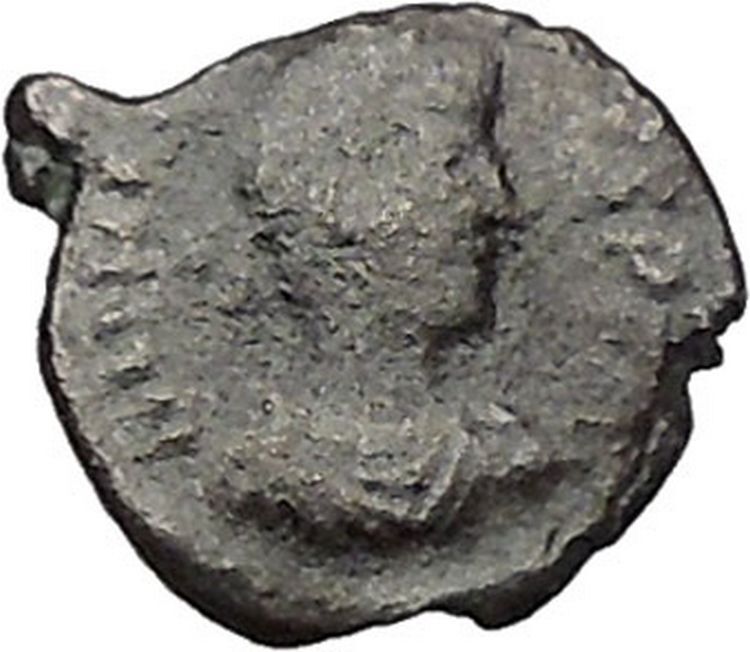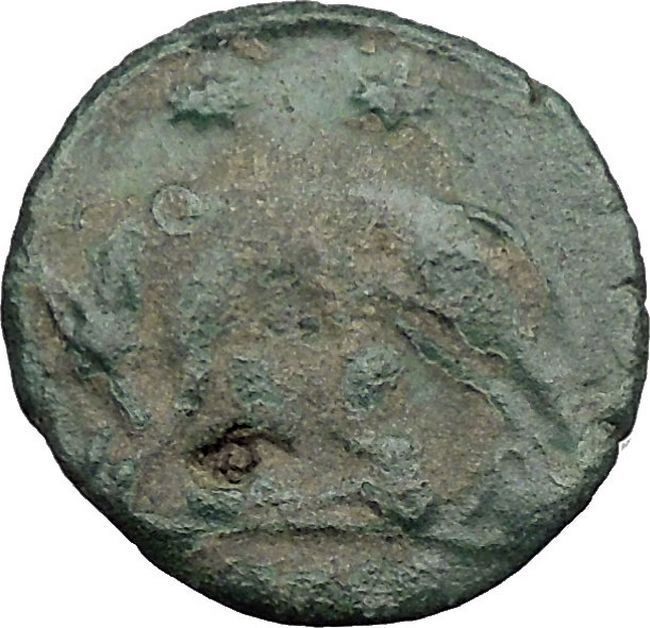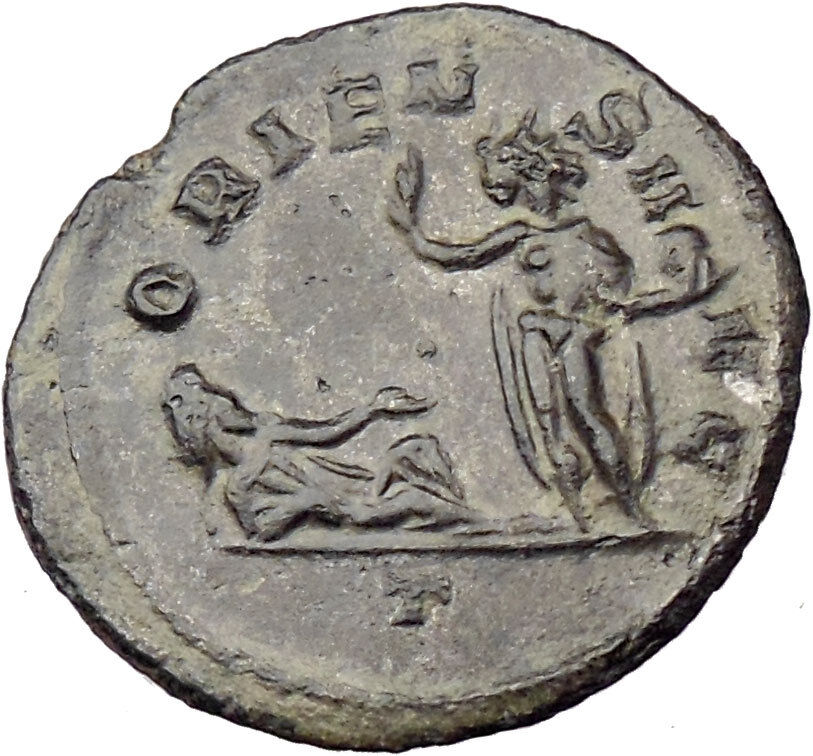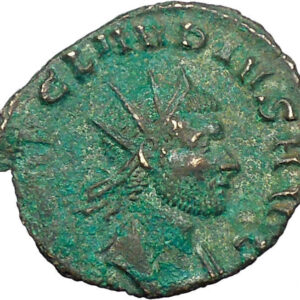|
Constans
–
Roman Emperor
: 337-350 A.D. –
Son of Constantine I Great Constans as Caesar, 333-337 A.D.
Bronze AE3 19mm (2.65 grams) Constantinople mint 333-335 A.D.
Reference: RIC VII 83
F L CONSTANS NOB CAES, laureate, draped and cuirassed bust left
GLORIA EXERCITVS, two solders with spears and shields, two standards
between,
dot CONSIA dot in ex.
*Numismatic Note: The reverse legend dedicates this coin to “the glory of the
Army.”
You are bidding on the exact item pictured,
provided with a Certificate of Authenticity and Lifetime Guarantee of
Authenticity.
Standards
.jpg/400px-035_Conrad_Cichorius,_Die_Reliefs_der_Traianssäule,_Tafel_XXXV_(Ausschnitt_01).jpg)
Roman military standards. The standards with discs, or signa
(first three on left) belong to centuriae of the
legion (the image does not show the heads of the standards – whether
spear-head or wreathed-palm). Note (second from right) the
legion’s
aquila
. The standard on the
extreme right probably portrays the
She-wolf
(lupa) which fed
Romulus
, the legendary founder of
Rome. (This was the emblem of
Legio VI Ferrata
, a legion then
based in
Judaea
, a detachment of which is
known to have fought in Dacia). Detail from Trajan’s Column, Rome

Modern reenactors parade with replicas of various legionary
standards. From left to right: signum (spear-head type), with
four discs; signum (wreathed-palm type), with six discs;
imago of ruling emperor; legionary aquila; vexillum
of commander (legatus) of
Legio XXX Ulpia Victrix
, with
embroidered name and emblem (Capricorn) of legion
Each tactical unit in the imperial army, from centuria upwards, had
its own standard. This consisted of a pole with a variety of adornments that was
borne by dedicated standard-bearers who normally held the rank of duplicarius.
Military standards had the practical use of communicating to unit members where
the main body of the unit was situated, so that they would not be separated, in
the same way that modern tour-group guides use umbrellas or flags. But military
standards were also invested with a mystical quality, representing the divine
spirit (genius) of the unit and were revered as such (soldiers frequently
prayed before their standards). The loss of a unit’s standard to the enemy was
considered a terrible stain on the unit’s honour, which could only be fully
expunged by its recovery.
The standard of a centuria was known as a signum, which was
borne by the unit’s signifer. It consisted of a pole topped by either an
open palm of a human hand or by a spear-head. The open palm, it has been
suggested, originated as a symbol of the
maniple
(manipulus = “handful”), the
smallest tactical unit in the
Roman army of the mid-Republic
. The poles were
adorned with two to six silver discs (the significance of which is uncertain).
In addition, the pole would be adorned by a variety of cross-pieces (including,
at bottom, a crescent-moon symbol and a tassel). The standard would also
normally sport a cross-bar with tassels.
The standard of a Praetorian cohort or an auxiliary cohort or ala was
known as a vexillum
or banner. This was a square flag,
normally red in colour, hanging from a crossbar on the top of the pole. Stitched
on the flag would be the name of the unit and/or an image of a god. An exemplar
found in Egypt bears an image of the goddess Victory on a red background. The
vexillum was borne by a vexillarius. A legionary detachment (vexillatio)
would also have its own vexillum. Finally, a vexillum
traditionally marked the commander’s position on the battlefield.[194]
The exception to the red colour appears to have been the Praetorian Guard, whose
vexilla, similar to their clothing, favoured a blue background.
From the time of
Marius
(consul 107 BC), the standard of all
legions was the
aquila
(“eagle”). The pole was surmounted
by a sculpted eagle of solid gold, or at least gold-plated silver, carrying
thunderbolts in its claws (representing
Jupiter
, the highest Roman god. Otherwise the
pole was unadorned. No exemplar of a legionary eagle has ever been found
(doubtless because any found in later centuries were melted down for their gold
content). The eagle was borne by the aquilifer, the legion’s most senior
standard-bearer. So important were legionary eagles as symbols of Roman military
prestige and power, that the imperial government would go to extraordinary
lengths to recover those captured by the enemy. This would include launching
full-scale invasions of the enemy’s territory, sometimes decades after the
eagles had been lost e.g. the expedition in 28 BC by
Marcus Licinius Crassus
against
Genucla
(Isaccea, near modern
Tulcea
, Rom., in the Danube delta region), a
fortress of the Getae
, to recover standards lost 33 years
earlier by
Gaius Antonius
, an earlier
proconsul
of
Macedonia
. Or the campaigns of AD 14-17 to
recover the three eagles lost by
Varus
in AD 6 in the
Teutoburg Forest
.
Under Augustus, it became the practice for legions to carry portraits (imagines)
of the ruling emperor and his immediate family members. An imago was
usually a bronze bust carried on top of a pole like a standard by an
imaginifer.
From around the time of Hadrian (r. 117-38), some auxiliary alae
adopted the dragon-standard (draco) commonly carried by Sarmatian cavalry
squadrons. This was a long cloth wind-sock attached to an ornate sculpture of an
open dragon’s mouth. When the bearer (draconarius) was galloping, it
would make a strong hissing-sound.
Decorations
The Roman army awarded a variety of individual decorations (dona) for
valour to its legionaries. Hasta pura was a miniature spear; phalerae
were large medal-like bronze or silver discs worn on the cuirass; armillae
were bracelets worn on the wrist; and
torques were worn round the neck, or on the cuirass. The highest
awards were the coronae (“crowns”), of which the most prestigious was the
corona civica, a crown made oak-leaves awarded for saving the life of a
fellow Roman citizen in battle. The most valuable award was the corona
muralis, a crown made of gold awarded to the first man to scale an enemy
rampart. This was awarded rarely, as such a man hardly ever survived.
There is no evidence that auxiliary common soldiers received individual
decorations like legionaries, although auxiliary officers did. Instead, the
whole regiment was honoured by a title reflecting the type of award e.g.
torquata (“awarded a torque”) or armillata (“awarded bracelets”).
Some regiments would, in the course of time, accumulate a long list of titles
and decorations e.g. cohors I Brittonum Ulpia torquata pia fidelis c.R..
Constans (Latin:
Flavius Julius Constans Augustus)
(c.323–350) was
Roman Emperor
from 337 to 350. He defeated his
brother
Constantine II
in 340, but anger in the army
over his personal life and preference for his barbarian bodyguards led the
general Magnentius
to rebel, resulting in the
assassination of Constans in 350.

Career
Constans was the third and youngest son of
Constantine the Great
and
Fausta
, his father’s second wife. He was
educated at the court of his father at
Constantinople
under the tutelage of the poet
Aemilius Magnus Arborius
.
On 25 December 333, Constantine I elevated Constans to the rank
of
Caesar
at
Constantinople
. Constans became engaged to
Olympias
, the daughter of the
Praetorian Prefect
Ablabius
, but the marriage never came to
pass.With Constantine’s death in 337, Constans and his two brothers,
Constantine II
and
Constantius II
, divided the Roman world between
themselves and disposed of virtually all relatives who could possibly have a
claim to the throne.The army proclaimed them
Augusti
on September 9, 337. Almost
immediately, Constans was required to deal with a
Sarmatian
invasion in late 337, over whom he
won a resounding victory.

Division of the Roman Empire among the Caesars appointed by
Constantine I
: from left to right,
the territories of
Constantine II
, Constans,
Dalmatius
and
Constantius II
. After the death of
Constantine I (May 337), this was the formal division of the Empire,
until Dalmatius was killed and his territory divided between
Constans and Constantius.
Constans was initially under the guardianship of Constantine II. The original
settlement assigned Constans the
praetorian prefectures
of
Italy and Africa
. Constans was unhappy with
this division, so the brothers met at
Viminacium
in 338 to revise the boundaries.
Constans managed to extract the prefecture of
Illyricum
and the
diocese of Thrace
,provinces that were
originally to be ruled by his cousin
Dalmatius
, as per Constantine I’s proposed
division after his death. Constantine II soon complained that he had not
received the amount of territory that was his due as the eldest son.
Annoyed that Constans had received Thrace and
Macedonia
after the death of Dalmatius,
Constantine demanded that Constans hand over the African provinces, which he
agreed to do in order to maintain a fragile peace. Soon, however, they began
quarreling over which parts of the African provinces belonged to
Carthage
, and thus Constantine, and which
belonged to Italy
, and therefore Constans. This led to
growing tensions between the two brothers, which were only heightened by
Constans finally coming of age and Constantine refusing to give up his
guardianship. In 340 Constantine II invaded Italy. Constans, at that time in
Dacia
, detached and sent a select and
disciplined body of his Illyrian troops, stating that he would follow them in
person with the remainder of his forces. Constantine was eventually trapped at
Aquileia
, where he died, leaving Constans to
inherit all of his brother’s former territories –
Hispania
,
Britannia
and
Gaul.
Constans began his reign in an energetic fashion. In 341-42, he led a
successful campaign against the
Franks
, and in the early months of 343 he
visited
Britain
. The source for this visit,
Julius Firmicus Maternus
, does not provide a
reason, but the quick movement and the danger involved in crossing the
channel
in the dangerous winter months suggests
it was in response to a military emergency, possibly to repel the
Picts
and
Scots
.
Regarding religion, Constans was tolerant of Judaism but promulgated an edict
banning pagan sacrifices in 341. He suppressed
Donatism
in Africa and supported
Nicene orthodoxy
against
Arianism
, which was championed by his brother
Constantius. Although Constans called the
Council of Sardica
in 343 to settle the
conflict, it was a complete failure, and by 346 the two emperors were on the
point of open warfare over the dispute. The conflict was only resolved by an
interim agreement which allowed each emperor to support their preferred clergy
within their own spheres of influence.
Death
In the final years of his reign, Constans developed a reputation for cruelty
and misrule.
Dominated by favourites and openly preferring his select
bodyguard, he lost the support of the
legions
who were also offended by his
homosexuality. In 350, the general
Magnentius
declared himself emperor at
Augustodunum
with the support of the troops on
the Rhine
frontier, and later the western provinces
of the Empire. Constans was enjoying himself nearby when he was notified of the
elevation of Magnentius.
Lacking any support beyond his immediate household, he was
forced to flee for his life. As he was trying to reach either Italy or Spain,
supporters of Magnentius cornered him in a fortification in
Vicus Helena
(now
Elne) in the
Pyrenees
, southwestern
Gaul
, where he was killed after seeking
sanctuary in a temple.
|





.jpg/400px-035_Conrad_Cichorius,_Die_Reliefs_der_Traianssäule,_Tafel_XXXV_(Ausschnitt_01).jpg)






